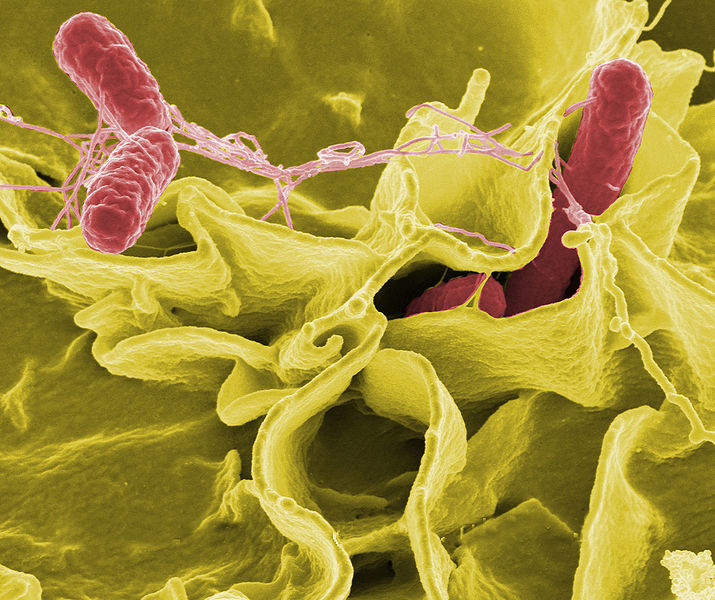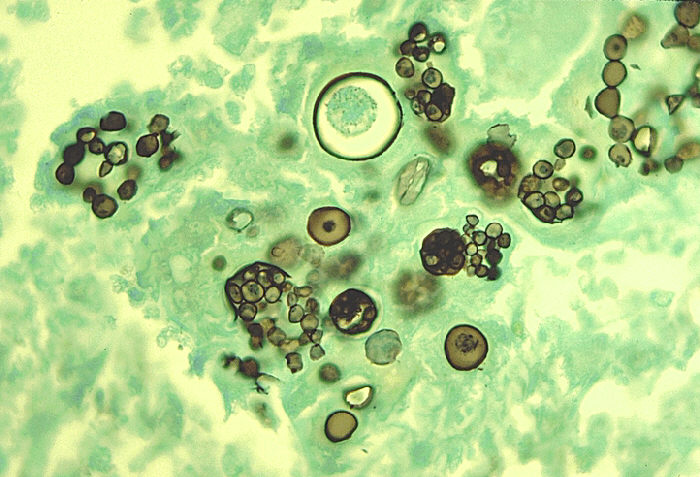Salmonella is a genus of gram negative rods, which are motile, non-spore forming and non-encapsulated facultative anaerobes. These bacteria cause typhoid fever, enterocolitis and septicemia.
Pathogenesis
Route of Entry
• Ingestion of food and water contaminated by human and animal wastes
• Salmonella Typhi is transmitted only by humans.
• Most frequent animal source is poultry and eggs.
• Undercooked meat is also a source
Dose of bacteria required is 100 million
Salmonella has all 3 antigens:
• O or somatic
• H or flagella
• K or capsular
Somatic antigen contains lipopolysaccharide toxin.
Virulence Factors
Important virulence factors include:
• Pili
• Capsule
• Endotoxin- Lipopolysaccharide
• Enterotoxin
• Protein invasion
Invasion:
Invasion allows non-phagocytic cells to take up bacteria, where bacteria are able to live intracellularly.
Predisposing Factors
• Patients suffering from chronic diseases
• Low hygiene
• Pets e.g dogs
• Undercooked meat
• Unpasteurized milk or dairy products
Lab- Diagnosis
Specimen
• Blood during first 10 days of infection
• Faces during 2nd -3rd week of infection
• Urine during 2nd week of infection

Microscopy
Salient features seen on microscopy are:
• Gram negative rods
• Motile
• Non-spore forming
• Non- capsulate expect
• Facultative anaerobe
• Pili are present
Culture
Bacteria may be grown on:
1. Blood Agar
Grey-white colonies are formed, which are non- hemolytic.
2. XLD
a. H2S producers form pink, red colonies with black centers
b. Non- H2S producers form pink, red colonies without black centers
3. MacConkey’s agar
Colorless colonies are formed.
Biochemical Tests
Triple sugar iron (TSI) test
On triple sugar iron test, alkaline slant and acidic butt is produced. H2S gas may also be produced.
• Urease Negative
• Indole Negative
• Lactase Negative
• B. Galactosidase Negative
• Oxidase Negative
• Urine Nitrate test positive i.e. converts nitrates to nitrites
• Ferment Glucose
Serological Tests
• Widal Test- detecting a rise in antibody titer in patient’s serum
• IGM antibody Immunoassays
• PCR
Diseases
Enterocolitis
Enterocolitis is characterized by an inversion of the epithelial and sub epithelial tissue of the small and large intestine, strains penetrate both through and between the mucosal cells in to the lamina propria, causing inflammation and diarrhea.
Asymptomatic carriage in gallbladder takes place as well.
Carriers excrete 1-1000 million Salmonella typhi /gm in faces and urine.
Typhoid
Infection beings in the small intensive but without gastrointestinal symptoms of peyer’s patches, then spreads to the phagocytes of the liver, gallbladder and spleen.
In bacteremia, fever and other symptoms are caused by endotoxin.
Organisms if present within phagosomes in phagocytes of the gallbladder, leads to carrier state.
Septicemia
Septicemia usually occurs in patients with underlying chronic diseases e.g sickle cell anemia or cancer or enterocolitis.
Clinical Symptoms
Enterocolitis:
Diarrhea, vomiting, fever and abdominal pain within 12-36 hours after ingestion of infected food.
Bacteraemia
Osteomyelitis, pneumonia and meningitis are the main symptoms.
Enteric Fevers
Main symptoms include typhoid, persistent high fever, low pulse rate, severe headache, toxemia, enlargement of the spleen, nausea, mental confusion and rose spots.
Treatment
• Enterocolitis is self limited disease, thus no treatment is required.
• Antimicrobials are needed for neonates and chronically ill patients
• In typhoid fever ciprofloxacin is given
 howMed Know Yourself
howMed Know Yourself




